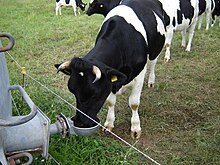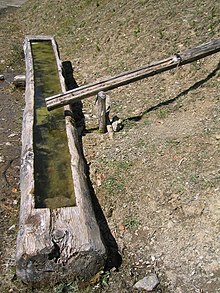Potions
At a potions ( French abreuvoir , Spanish Abrevadero , Italian abbeveratoio ) animals water to drink. In the terrarium special potions depending on the requirements for use, for example. B. Dripper .
history
Watering facilities can be of a natural type (river, stream, pond, etc.) or artificially created by humans in order to supply livestock with water or to give wild animals easier access to vital water.
In the countryside, before the advent of intensive livestock farming , an artificially created pond was often used as a drinking place for all of the community's livestock. Also troughs (formerly often sarcophagi ) to broader sources or fountains of water intake served by sheep, goats, cattle, donkeys and horses.
Already at the triumphal arch of Volubilis , Morocco, there were two water basins to supply the mounts with water.
Artificial potions
In pig farming, a special distinction is made between nipple drinkers and basin drinkers / bowl drinkers.
Nipple potions
In the case of nipple drinkers (especially found in pigs and piglets), contamination can be almost ruled out because the animals suckle on it. Nipple drinkers are sometimes adjustable in height and can thus be adjusted to the size of the animals. The installation height should always be approx. 5–10 cm higher than the back height of the animals. If no height adjustment is provided, several nipple drinkers are often installed at different heights.
With nipple drinkers, the water is more likely to be splashed into the mouth of the animals. You can see that a lot of water runs past the animals' mouths, so water consumption is not economical.
Self potions
With self-drinking, the animal can use its mouth to operate a valve in the drinking bowl using a mechanism built in for this purpose and thus fill the drinking water with water. This means that fresh tap water is always available and contamination of the water is prevented.
For the pasture, there are self-watering systems with a pump that, when activated by the animals, supplies water e.g. B. promoted from a stream.
With self-watering, the liquid intake of cows is often not optimal, as the amount of water flowing in may be too small and the animals stop the process after a while. In addition, animals that are not injured in their mouths or front teeth can use this drinker unhindered.
There are also self-waterers with a float valve; With these, the animal does not have to open the valve with its mouth, but a level is regulated similar to that in a toilet cistern . Such drinking troughs are also available with thermal insulation, which prevents freezing outdoors even in frosty conditions. To do this, however, enough animals have to drink in order to allow enough water to flow into the ground. The drinking opening in these devices is closed with a plastic ball in order to reduce heat loss.
Pool drinkers
Basin drinkers in the form of stone or wooden troughs have been around for a long time. They can still be found in pasture farming even today. In the stable they are made of stainless steel or enamelled cast iron. The advantage of drinking bowls over nipple drinkers is the lower loss of water and the better water absorption of the animals.
The water intake at basin or bowl drinkers corresponds more to the natural drinking behavior of the animals.
In the farrowing pen of domestic pigs , basins are sometimes built in that are shared by both the sow and the piglets. The advantage is that the piglets will immediately accept this watering because the animals can see the water. If a float valve is installed in the inlet, water will automatically run in as soon as the water level has fallen below a certain level.
In cattle farming, preheated water is sometimes offered in basin drinkers, for example in combination with milk pre-cooling. This warm water is better absorbed by the animals and the animals, which take in large amounts of water from these basins in a short time, do not lose as much heat energy to the water.
Regulations
The pig keeping hygiene regulation always stipulates a drinking point for a maximum of 12 pigs.
In pig farming, medication is sometimes administered to the animals via the drinking water. The installation regulations (DIN 1988, Protection of Drinking Water) require suitable measures to prevent water contaminated by a pressure loss in the water pipe from flowing back into the pipe.





